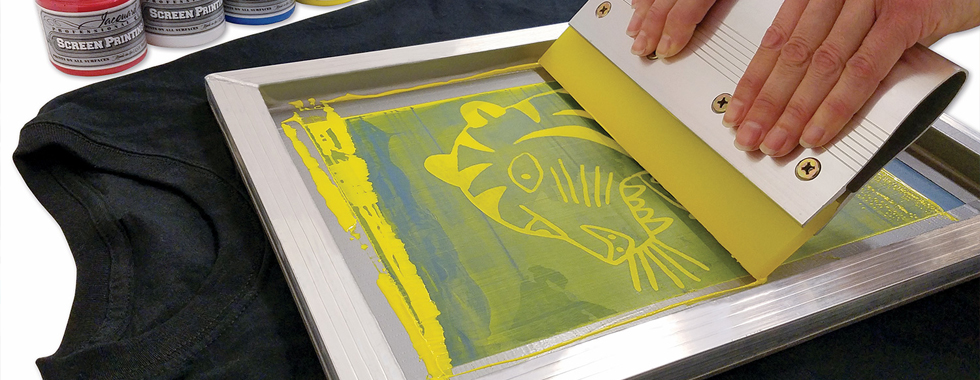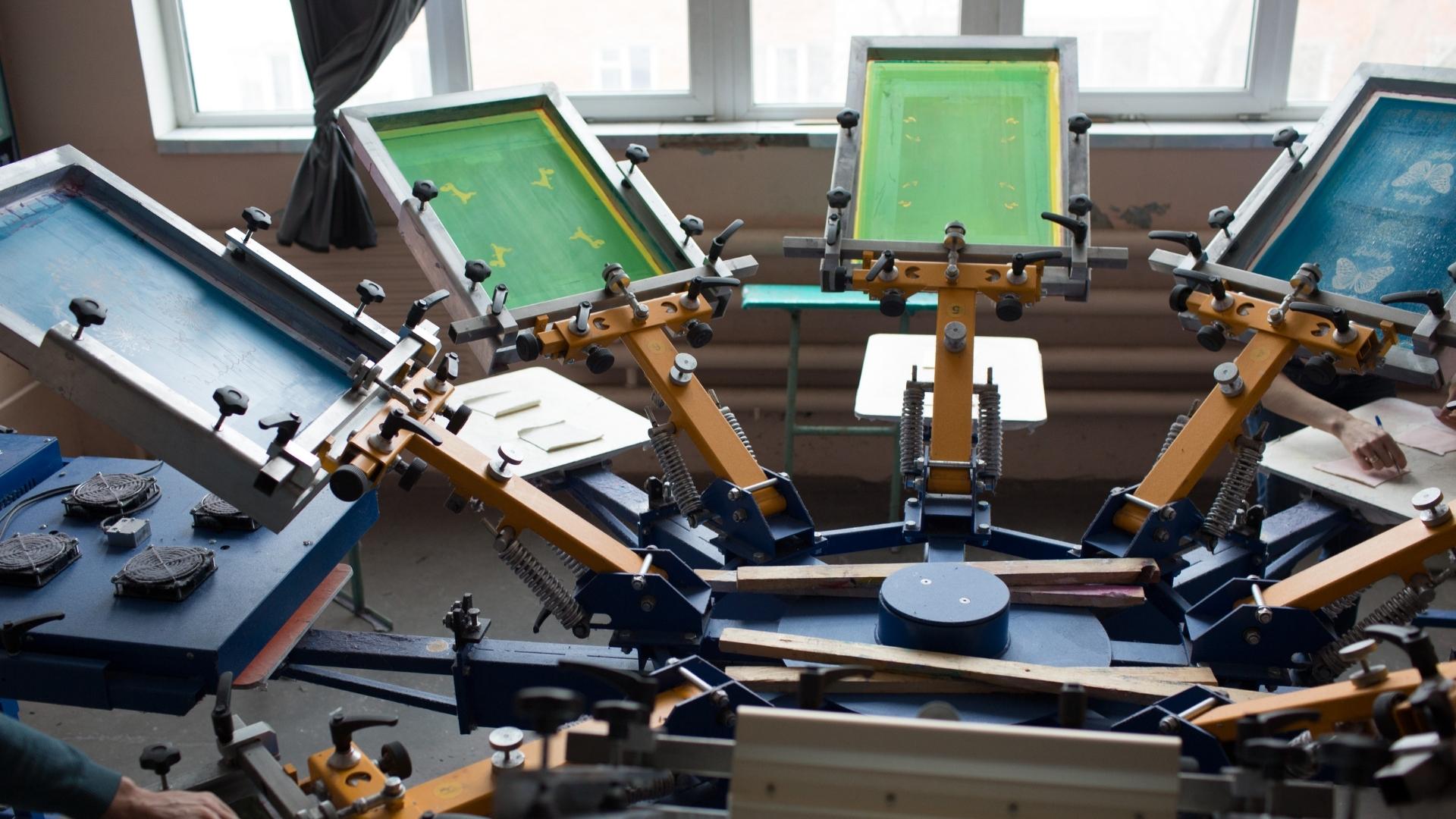Discover the Various Sorts Of Screen Printing Techniques for Your Following Project
Screen printing supplies a diverse variety of methods that can boost any kind of creative project. From typical techniques like serigraphy to modern-day innovations such as direct-to-garment printing, each strategy has its one-of-a-kind benefits. Specialty choices, including environment-friendly and metal inks, present a lot more possibilities. Understanding these methods can considerably impact the last result. The challenge exists in picking the most ideal method for specific needs and preferred impacts. What elements should one take into consideration?

The Fundamentals of Screen Printing
Screen printing may appear facility, it is basically an uncomplicated process that involves moving ink via a mesh screen onto different surface areas. The technique begins with the creation of a pattern, which defines the style to be printed. This stencil is affixed to a mesh screen, usually made from polyester or nylon. As soon as the pattern remains in place, ink is related to the screen and pushed with the mesh using a squeegee, leading to the wanted pattern being printed on the underlying product.
Screen printing can be done on a large variety of substratums, including material, paper, and plastic, making it a flexible choice for numerous tasks. The process enables elaborate styles and vivid colors, making it popular in markets such as marketing, art, and style. Understanding these basics outfits individuals with the foundational expertise required to explore even more advanced strategies in screen printing.
Typical Screen Printing Techniques
Conventional screen printing techniques have actually been employed for centuries, preserving the craftsmanship and artistry of this technique. This technique uses a mesh screen to transfer ink onto a substratum, such as material or paper, permitting lively and durable layouts. The process starts with producing a stencil, which obstructs particular areas of the screen to control where the ink will be applied.
One preferred method is serigraphy, typically utilized for imaginative prints and limited editions. One more is the use of water-based inks, which are eco-friendly and offer a soft feeling on textiles - 10:9 Design Company. Furthermore, conventional approaches can include hand-operated printing, where craftsmens apply ink with a squeegee, making certain precision and focus to information
These strategies continue to be valued in the sector for their responsive top quality and the distinct textures they generate, attracting both consumers and creators that value the heritage of screen printing.
Digital Screen Printing Innovations
As the demand for faster production and customization in the printing sector has actually risen, digital screen printing developments have become a game-changer. This technology blends conventional screen printing methods with digital processes, enabling rapid prototyping and intricate layouts that were formerly difficult to attain. One substantial development is the introduction of direct-to-garment (DTG) printing, which promotes high-grade, full-color prints on numerous fabrics without the demand for screens. Additionally, innovations in ink formulas have resulted in environment-friendly options that maintain lively colors while lessening environmental impact. Making use of automated systems better improves manufacturing, minimizing labor expenses and boosting accuracy. These innovations not just cater to little batch orders and personalized styles yet likewise enable quicker turnaround times, making them perfect for services concentrated on conference customer demands in a busy market. Digital screen printing, as a result, stands for an important development in the domain of printing strategies.
Specialized Screen Printing Techniques
Checking out specialized screen printing approaches discloses a varied selection of methods that push the boundaries of imagination and functionality in the printing industry. Among these, glow-in-the-dark inks provide a special aesthetic impact, making styles come active in low-light problems. Metal inks, understood for their shimmering coating, include a touch of deluxe to printed products. One more innovative approach is discharge printing, which eliminates dye from the material rather than including ink, causing a soft, classic feel. High-density printing develops a raised texture on the surface area, enhancing responsive involvement. Additionally, water-based inks are acquiring appeal for their lively shades and lowered environmental impact. Each of these specialty strategies caters to specific layout demands, allowing brands and artists to produce standout items that resonate with their target markets. By leveraging these methods, services can boost their screen printing jobs to new heights, guaranteeing remarkable impressions.
Eco-Friendly Screen Printing Options
Green screen printing options are getting traction as the sector moves in the direction of sustainability. Sustainable ink selections and using eco-friendly products are crucial components in decreasing the ecological effect of the printing process. By adopting these techniques, screen printers can contribute to a more sustainable future while maintaining top notch results.
Sustainable Ink Selections

Biodegradable Products Usage
As the screen printing market advances, the incorporation of naturally degradable materials is ending up being increasingly crucial for environmentally mindful practices. Manufacturers and designers are currently discovering inks and substrates made from all-natural, eco-friendly sources that decay more efficiently than traditional equivalents. These eco-friendly options minimize plastic waste and lessen ecological influence, lining up with the growing demand for sustainable items.
Typical examples consist of water-based inks and organic cotton materials, both of which minimize hazardous chemicals and advertise eco-friendliness. Brands that adopt these products frequently improve their market charm, drawing in customers that focus on sustainability. As understanding of ecological issues proceeds to increase, the shift in the direction of biodegradable products in screen printing is most likely to get energy, cultivating a greener market standard.
Selecting the Right Method for Your Task
How can one figure out one of the most appropriate screen printing strategy for a details job? The choice depends upon numerous elements, consisting of the product to be published on, the complexity of the layout, and the wanted production quantity - 10:9 Design contact. For circumstances, direct-to-garment printing is ideal for detailed styles with many colors, while traditional screen printing excels for bigger runs of simpler graphics
In addition, consideration of the end-use of the printed thing is necessary. For outside applications, techniques that supply resilience and weather resistance, such as plastisol ink, may be preferred. Conversely, environmentally-conscious tasks might profit from biodegradable products or water-based inks.
Inevitably, comprehending the task's special requirements enables an informed selection, ensuring both aesthetic appeal and functional long life. By evaluating layout intricacy, product compatibility, and production range, one can properly pick one of the most appropriate screen printing technique to satisfy their project's goals.
Regularly Asked Questions
What Is the History of Screen Printing?
Screen printing came from ancient China around 1000 ADVERTISEMENT, evolving through Japan and Europe. By the 20th century, it ended up being prominent in industrial art and fashion, changing just how layouts were produced and distributed internationally.

How Do I Prepare Art Work for Screen Printing?
To prepare art work for screen printing, one need to ensure high resolution, utilize an ideal shade setting, develop different layers for every color, and convert message to outlines, guaranteeing compatibility with the printing process and wanted outcome.
What Products Are Finest for Screen Printing?
The best products for screen printing include top quality inks, resilient displays, and suitable substratums like cotton, polyester, or blends. Furthermore, making use of suitable emulsion and squeegees can improve the printing process and final outcomes.
Can I Evaluate Print at Home?
Yes, screen printing in your home is feasible. With the appropriate products, configuration, and methods, individuals can produce high-quality prints. Nevertheless, careful consideration of office and devices is vital for successful outcomes.

What Are Usual Errors in Screen Printing?
Typical mistakes in screen printing consist of inappropriate exposure times, poor ink uniformity, misalignment of displays, inadequate cleansing of products, and overlooking to test prints. These mistakes can compromise the high quality and precision of the end product.
Screen printing may appear facility, it is fundamentally an uncomplicated process that entails moving ink with a mesh screen onto numerous surfaces. As the need for faster production and customization in the printing sector has actually risen, electronic screen printing developments have emerged as a game-changer. Checking out specialty screen printing approaches reveals a varied range of methods that push the borders of creative thinking and performance in the printing industry. The finest materials website for screen printing include premium inks, sturdy screens, and suitable substratums like cotton, polyester, or blends (10:9 Design Embroidery). Common mistakes in screen printing consist of improper exposure times, poor ink consistency, imbalance of screens, insufficient cleaning of products, and overlooking to examine prints